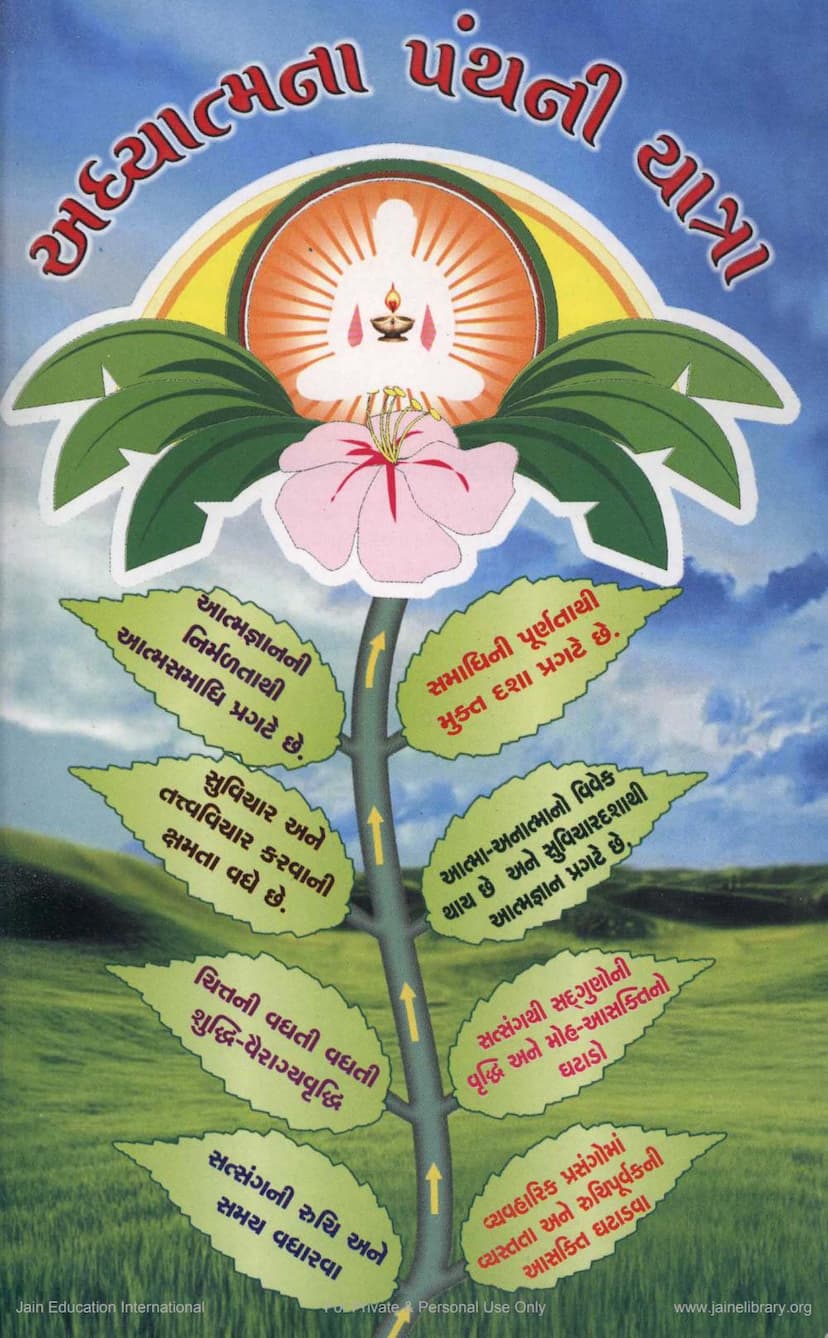Adhyatmana Panthni Yatra
Added to library: September 1, 2025

Summary
This document is a summary and commentary on selected letters of Shri Atmanandji Maharaj, based on the teachings of Shrimad Rajchandraji. The book is titled "Adhyatmana Panthni Yatra" (The Journey on the Path of Spirituality).
Here's a breakdown of the key themes and content based on the provided text:
Overall Purpose and Scope:
- The book aims to guide spiritual seekers on their path towards self-realization and liberation (moksha).
- It focuses on interpreting specific letters of Shrimad Rajchandraji (numbers 254, 493, 525, and 569) to provide practical spiritual guidance.
- The commentary is intended to be accessible to both beginners and advanced spiritual practitioners.
- The overarching theme is the journey towards spiritual understanding and liberation, emphasizing the teachings of Shrimad Rajchandraji.
Key Concepts and Themes:
-
The Nature of Spirituality and Liberation:
- Spiritual knowledge (Atma-jnana) leads to inner peace (Atma-samadhi).
- Inner peace culminates in the liberated state (Mukta-dasha).
- The importance of contemplation and the ability to distinguish between the soul (Atma) and the non-soul (Anatma).
- The cultivation of virtues like increased purity of mind, detachment (vairagya), spiritual inclination (sangati), and reduction of attachment (moha).
-
The Role of the Guru and Spiritual Guidance:
- The importance of the words of a knowledgeable person (Jnani) as a guide on the spiritual path.
- The author emphasizes the profound impact of Shrimad Rajchandraji's words, drawing parallels to his influence on Mahatma Gandhi.
- Shrimad Rajchandraji's teachings are presented as theoretically sound and experientially rooted, capable of inspiring spiritual seekers.
-
Commentary on Specific Letters:
-
Letter 254:
- Focuses on the lack of spiritual desire (Mumukshutva) as a primary obstacle.
- Defines Mumukshutva and stresses the need for self-introspection and relinquishing self-will (swachhand).
- Identifies three key obstacles to spiritual progress:
- Lingering desire for worldly pleasures.
- Lack of profound humility.
- Indecision about reality (non-resolution of principles).
- Highlights the importance of identifying with a true spiritual master (Mahatma) to overcome attachment and gain clarity.
- Encourages continuous engagement in spiritual discussions and contemplation.
-
Letter 493 (Six-Point Letter):
- Addressed to a key monastic disciple (Shri Laghuraj Swami).
- Explains six fundamental principles essential for spiritual realization:
- The soul (Atma) exists.
- The soul is eternal.
- The soul is the doer (Karta).
- The soul is the experiencer (Bhokta).
- Liberation (Moksha) is attainable.
- Liberation has a specific path.
- Emphasizes that understanding these six principles leads to true self-realization (Samya-darshan) and ultimately to the cessation of suffering and attainment of liberation.
- Showcases a beautiful synthesis of the paths of knowledge (Jnana) and devotion (Bhakti).
-
Letter 525:
- Focuses on the state of the soul after attaining self-knowledge (Atma-jnana), emphasizing the path forward.
- Explains the difference between 'self-state' (Atma-bhava) and 'other-state' (Anya-bhava), with three types of consciousness: unwholesome (ashubh), wholesome (shubh), and pure (shuddha).
- Highlights the importance of discerning these states for spiritual progress.
- Stresses the significance of devotion to great souls (Satpurush) and the true nature and fruit of devotion to the Guru (Sadguru), which is self-realization (Atma-bodh).
-
Letter 569:
- Addresses the importance of self-reflection and the path to liberation.
- Emphasizes that self-knowledge is the sole remedy for all suffering.
- Details the step-by-step process for attaining spiritual knowledge and the obstacles to be overcome.
- Discusses concepts like attachment, negligence (pramada), the role of a muni (ascetic), the connection between self-knowledge and self-tranquility (Atma-samadhi), and the need for heightened awareness.
- Stresses the importance of detachment, reducing worldly desires and attachments, and the need for continuous effort.
-
Structure and Presentation:
- Each letter is introduced with a summary (Tuksar).
- The main body of the text provides detailed commentary (Vishesharth) on the original teachings.
- References to relevant scriptures and texts are provided in footnotes.
- The language used is Gujarati, with occasional Sanskrit-Prakrit quotes translated into Gujarati.
- The book is published by Shrimad Rajchandra Sadhna Kendra, Koba.
Key Takeaways for the Seeker:
- Discernment: The ability to distinguish between the soul and the non-soul, between true spiritual principles and worldly attachments.
- Detachment: Reducing worldly desires and attachments is crucial for spiritual progress.
- Humility and Devotion: Cultivating humility and devotion towards the Guru and enlightened beings is essential.
- Self-Effort: Spiritual progress requires consistent effort, self-reflection, and adherence to the teachings.
- The Importance of the Human Birth: The human birth is presented as a rare and precious opportunity for spiritual liberation.
- The Power of Sincere Intention: A genuine desire for liberation and a clear understanding of the path are paramount.
In essence, "Adhyatmana Panthni Yatra" serves as a profound spiritual guide, drawing from the wisdom of Shrimad Rajchandraji and elucidated by Shri Atmanandji Maharaj, to lead sincere seekers towards the ultimate goal of spiritual liberation.